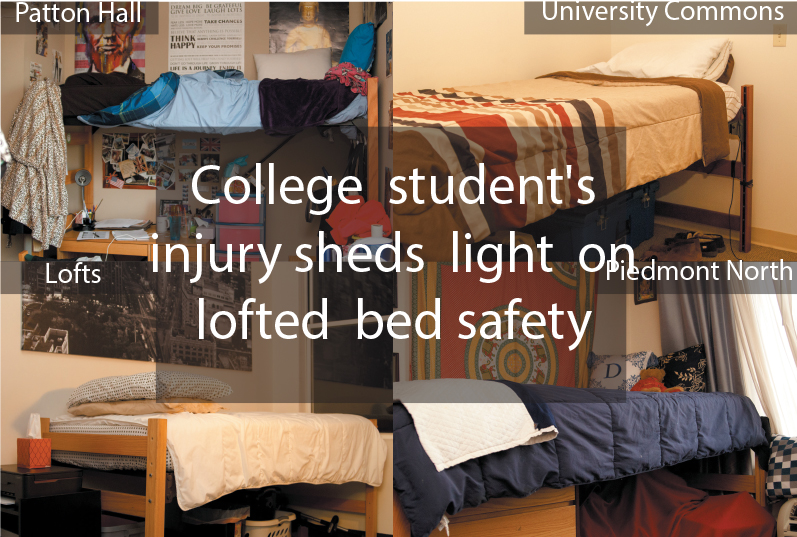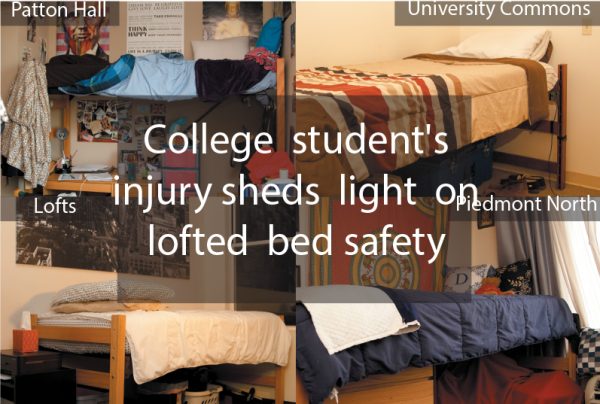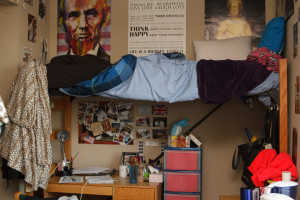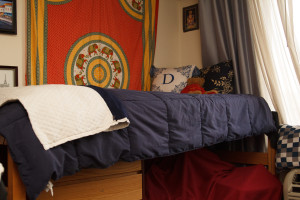

Photos by Ruth Pannill | The Signal
Clair Irvin & Lauren booker Staff Reporter and News Editor
When Clark Jacobs’ mother Marillen Jacobs noticed her son vomiting one morning, she originally thought he just had the flu. She later discovered the situation was a lot more critical.
Georgia State’s University Housing residents voiced apprehensions about their beds after Georgia Tech mechanical engineering major Jacobs fell from a lofted bed in Tech’s Kappa Sigma fraternity house on Jan. 10.
The fall caused Jacobs to fracture the base of his skull and suffer from brain bleed, according to Ms. Jacobs. WebMD states brain bleeding or hemorrhaging is a type of stroke that kills brain cells.
“To describe Clark’s accident as a nightmare come to life doesn’t even begin to account for the pain our family has endured. It is almost like our lives came to a halt on Jan. 10,” Ms. Jacobs said. “We are slowly coming back to life with him. The most difficult hours were the ones following his emergency brain surgery when we were told he might not live.”
To save Jacobs’ life, a portion of his cranium was removed to enable brain swelling, and cranioplasty was performed to restore the skull, according to Ms. Jacobs.
She said Jacobs fell from a bed with no railings, which is similar to some of Georgia State’s dormitory beds. Jacobs’ incident is also not the only case of injuries caused by falling off lofted beds.
On average there are approximately 36,000 cases of bunk bed-related injuries annually among children and young adults up to 21 years of age, according to a study published by Center for Injury Research and Policy of The Research Institute at Nationwide Children’s Hospital in 2008.
People ages 18 to 21 suffered from bed-related injuries twice more than 14- to 17-year-olds. This could be due to
young adults’ use of lofted or bunk beds in college dorms, according to the study.
The study states people are usually injured on their head and neck. The common types of injuries were lacerations, contusions/abrasions and fractures, with fractures being the third most frequent injury.
Since fracturing his skull, Jacobs’ health improved after his surgery. However, he faced issues after returning back home, according to Ms. Jacobs.
She said he caught pneumonia, then later contracted infections and blood clots in his arms and legs after arriving to the Shepherd Center.
The center is a hospital in Atlanta that provides rehabilitation to spinal cord and brain injury patients, according to their website.
Now Jacobs is at home until he regains full consciousness. He will then be brought back to the Shepherd Center to complete 90 days of inpatient therapy.
“He is conscious much more of the daytime now. He tracks with his eyes and is able to recognize words and answer questions through hand gestures or using his eyes,” Ms. Jacobs said.

Dorm room beds and safety
Georgia State’s Associate Director of Residence Life in University Housing Mylon Kirksy said Housing can provide railing to beds, but they are available on an as-needed basis.
“In short, our facilities staff does loft beds and provide railings for those students who submit a work order request,” he said. “We fulfill a majority of these requests early in the fall semester, and after that on an as-needed basis.”
Kirksy also said University Housing doesn’t automatically place railings beds because students have their own preferences on how they want to arrange their bedroom.
Ms. Jacobs said she has been campaigning to require railings on every bunk or loft bed.
“It is ridiculous to take a chance when the danger is so easily avoided. Many campus bunk beds don’t even have ladders, requiring the students to climb up the bed frame to get into bed,” she said.
Georgia Tech isn’t the only college that needs to add railings to their beds, all college campuses do, according to Ms. Jacobs.
“We are not picking on Georgia Tech as it is certainly not the only college campus in the country [or] world that needs to rethink their housing safety requirements,” she said. “I am so proud of the Kappa Sigma fraternity for hopping right on this and getting every single bed retrofitted with rails.”
The Nationwide Children’s Hospital study also recommends for there to be 3.5 inches or less guardrails on both sides of a bunk bed.
“Every one wants to feel safe and secure while resting or sleeping, yet bunk beds are a common source of injury among children and adolescents,” study co-author Lara McKenzie said in a Science Daily article.

Residents’ opinions about lofted beds
Patton Hall resident Shirley Tran said it is scary how lofted beds do not have a ladder.
“The ladder cannot even be used because it’s part of the bed, and the bed can only fit so much into a tiny dorm room. One of the beds has to be at a disadvantage so maybe add a ladder to at least one of the beds to increase safety,” she said.
Tran said students sleeping in lofted beds should get railings, because it isn’t worth the risk.
Jasmine Rojas, University Commons resident, said she questions if Housing’s beds need to be lofted.
“Last year I stayed at the [University] Lofts and my bed was really thick and hard and everything. But it was so high. Like, you couldn’t level it down for nothing. Like someone super glued it for some reason. So that was a pain,” she said “I’m a short person. I can’t just jump on the bed. I need a stool or something.”
Rojas said University Housing should provide railings for beds upon request and students with regular un-lofted beds for safety.
“I feel like if I was going to fall, that would be it for me,” she said.
NOTE: If you would like to donate to Clark’s medical expenses, go to Clark Jacob’s GoFundMe page at http://www.gofundme.com/teamclark.
The Signal also reached out to Director of University Housing Marilyn de La Roche for comment, who could not respond by press time. Updates will be posted online if comments are provided at a later time.
